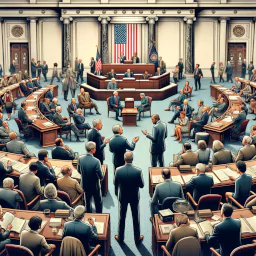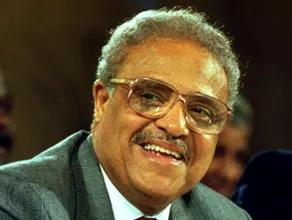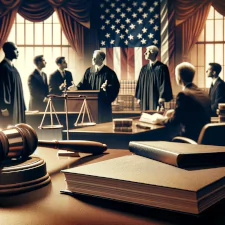The Voting Rights Act Amendments of 1982 were significant modifications to the original Voting Rights Act of 1965, a landmark civil rights law in the United States that aimed to overcome legal barriers at the state and local levels that prevented African Americans from exercising their right to vote.
What is the Voting Rights Act Amendments of 1982?
These amendments, signed into law by President Ronald Reagan on June 29, 1982, were enacted in response to challenges and legal interpretations that had arisen since the original Act’s passage. Key aspects of the 1982 amendments include:
- Standard for Determining Discrimination: Perhaps the most significant change was the modification of the standard for proving violations of Section 2 of the original Act. Before the amendments, plaintiffs had to prove that discriminatory intent was behind a voting procedure. The 1982 amendments shifted this to a “results test,” where plaintiffs only needed to show that the procedure had a discriminatory effect, regardless of intent.
- Extension of Bilingual Election Requirements: The amendments extended requirements for providing bilingual assistance to language minority voters. This was crucial in ensuring that non-English speakers could effectively participate in the electoral process.
- Reauthorization of Special Provisions: The amendments reauthorized for 25 years the special enforcement provisions of the Act, including the preclearance requirement of Section 5, which required jurisdictions with a history of discrimination to obtain federal approval for any changes to their voting laws or practices.
- Expansion of Coverage: The amendments expanded the coverage formula to include jurisdictions that had maintained a test or device as a prerequisite to voting as of 1972 and had low voter registration or turnout in the 1972 presidential election.
The 1982 amendments thus strengthened the Voting Rights Act’s provisions, ensuring greater protection against discriminatory practices and expanding the reach of its safeguards to more minorities, particularly in areas of language and voting procedures.
Key Takeaways:
- The amendments shifted the burden of proof from requiring plaintiffs to demonstrate discriminatory intent behind a voting procedure, to only needing to show that the procedure had a discriminatory effect, enhancing protections against discrimination.
- They extended requirements for providing bilingual assistance to language minority voters, ensuring non-English speakers could effectively participate in elections.
- The amendments reauthorized for 25 years the special enforcement provisions of the original Act, including the preclearance requirement, and expanded coverage to more jurisdictions with a history of discrimination.
Table of Contents
- Why we need the Voting Rights Act Amendments of 1982
- The 'Who': Key Players in making it happen
- Before 1982: Understanding the Original Voting Rights Act of 1965
- Birthing a Landmark Legislation: The Inception of Voting Rights Act
- The Call for Evolution: Why Amend the Original Act?
- Probing the Original Framework: Shortcomings and Loopholes
- Navigating New Challenges: Changing Times, Changing Needs
- The Amendment Process: How did it all come together?
- Legislative Journey: From Proposal to Law
- Key Changes Introduced by the Amendments of 1982
- Navigating Through Controversies and Legal Challenges
- Further Developments – Post-1982 Amendments till now
- Beyond Boundaries: Current Status & Future Prospects
- Reflecting on the Legacy of the Voting Rights Act Amendments
- Continuing the Fight for Equal Voting Rights
- Conclusion
Why we need the Voting Rights Act Amendments of 1982

Digging Deeper into The Why
So why exactly were these amendments necessary? At its heart, it boiled down to one fundamental issue: discrimination in voting practices hadn’t been eradicated—it had merely changed shape.
After the implementation of the original Act in 1965, certain jurisdictions found backdoor methods to uphold discriminatory practices while technically adhering to federal regulations. For instance, some places adopted ‘at-large’ voting systems which diluted minority votes and restricted their ability to elect representatives of their choosing.
In other areas, gerrymandering—the manipulation of electoral boundaries—took place so that racial minorities could not form a substantial voting bloc. These tactics upheld the spirit of discrimination while bypassing the legal constraints of the existing Voting Rights Act.
This insidious reality made it apparent that more needed to be done. The 1982 amendments sought to confront these challenges head-on by expanding federal oversight and placing stricter limitations on these discriminatory practices.
The ‘Who’: Key Players in making it happen
The Champions Bound by a Cause
Implementing such critical legislation was no easy task. It required the collective efforts of devoted politicians, civil rights activists, and even Supreme Court Justices—all committed to advancing equal voting rights for all citizens.
One of the most notable figures was Senator Bob Dole, who played a pivotal role in pushing this legislation through the Senate amidst significant opposition.
Civil rights leaders like Benjamin Hooks, Executive Director of NAACP, worked tirelessly to rally support for amending the Act.

Hooks attended Le Moyne College in Memphis (1941–43) and Howard University, Washington, D.C. (1943–44; B.A., 1944), served in the U.S. Army during World War II, and later studied law at De Paul University in Chicago (J.D., 1948); no law school in Tennessee was admitting blacks at that time
At the judicial level, Justices like Thurgood Marshall continued their unwavering advocacy for equal voting rights within legal frameworks. These key players worked relentlessly against considerable challenges but were united by their unwavering commitment to justice and equality—a testament to America’s enduring pursuit of “a more perfect Union.”
Before 1982: Understanding the Original Voting Rights Act of 1965
The Struggle for Equality: An Ode to the Civil Rights Movement
To fully grasp the essence of the Voting Rights Act Amendments of 1982, we must voyage back in time to comprehend its roots. The original Voting Rights Act of 1965 was not born in a vacuum; it was rather an offshoot of a much larger, profound social and political upheaval known as the Civil Rights Movement. As far back as the end of the American Civil War, African Americans had been fighting for their rights and equality.
However, despite the passage of amendments ensuring the right to vote, systemic measures like literacy tests, poll taxes, and outright intimidation tactics continued to stifle black voters. This brought forth waves upon waves of civil activism leading up to what we now recognize as the Civil Rights Movement from the mid-1950s through the late 60s.
The movement embodied struggles and sacrifices made by countless activists who relentlessly fought against racial segregation and discrimination. With prominent figures like Dr. Martin Luther King Jr., and Rosa Parks among others coming into play, these activists not only challenged societal norms but also provoked substantial changes at a legislative level.
Birthing a Landmark Legislation: The Inception of Voting Rights Act
It was amidst this turbulence that one monumental piece of legislation emerged – The Voting Rights Act (VRA) of 1965. Aimed at eliminating legal barriers preventing African Americans from exercising their right to vote under the Fourteenth and Fifteenth Amendments, VRA became a cornerstone in cementing democratic rights for all citizens.
The watershed moment leading up to VRA’s enactment was undoubtedly ‘Bloody Sunday’ on March 7th, 1965 when peaceful demonstrators marching from Selma to Montgomery in Alabama were attacked by law enforcement officers. The event was broadcast nationwide, thus galvanizing public sentiment and political will towards passing the VRA.
Enacted on August 6th, 1965 by President Lyndon B. Johnson, the Act prohibited racial discrimination in voting through different means: it banned literacy tests, provided for federal oversight of voter registration in areas where less than 50% of the non-white population had not registered to vote, and authorized the U.S. Attorney General to investigate the use of poll taxes in state and local elections. Upon its inception, VRA was hailed as the most effective piece of civil rights legislation ever passed by Congress.
The Call for Evolution: Why Amend the Original Act?
The Voting Rights Act of 1965 was undoubtedly a monumental legislation, a watershed in the struggle for equal voting rights. But as with any piece of legislation, it had its inadequacies. Over time, these became more and more apparent, prompting calls for changes.
Probing the Original Framework: Shortcomings and Loopholes
The original Act was primarily designed to deal with overt acts of discrimination – tests and tactics expressly designed to exclude African Americans from voting. It laid down stringent measures to combat such acts, which included suspending literacy tests and providing federal examiners to oversee voter registration in jurisdictions with a history of discrimination. However, the Act’s focus on ‘tests or devices’ restricted its scope somewhat.
There were other subtle but equally potent ways through which minority voters could be marginalized that fell outside this definition. One such glaring loophole was redistricting or gerrymandering – manipulating electoral boundaries in a way that diluted minority voting strength.
The Act’s provisions did not effectively address this problem. Moreover, even though Section 5 required certain jurisdictions with a history of discrimination to obtain federal pre-clearance before implementing any new voting practices or procedures; it didn’t cover all states practicing discriminatory tactics.
Navigating New Challenges: Changing Times, Changing Needs
As we moved further away from the 1960s, it became clear that demographic shifts and evolving socio-political scenarios necessitated an update to the existing legislation. The Civil Rights Movement had yielded significant victories; however, racial inequalities persisted subtly within society’s structures.
By the early 1980s, America was changing rapidly both in terms of population composition as well as political dynamics. The country had become much more diverse due to immigration influxes mainly from Latin America and Asia which increased language minorities who faced unique barriers when it came to voting.
In addition, there was a trend towards more sophisticated methods of voter suppression that didn’t involve outright violations like literacy tests but still served the same purpose. For instance, at-large elections – where voters from an entire city or county elect officials instead of voters from individual districts – often result in diluting minority votes and inhibiting minority representation.
The need for amending the Act was becoming increasingly pressing. The challenge was to broaden its protections while keeping its spirit intact and ensuring it remained relevant in a rapidly changing America.
The Amendment Process: How did it all come together?
Unraveling The Tapestry of Democracy:
The journey to the 1982 Amendments was both complex and comprehensive, imbued with intricate policy debates and monumental political decisions. It was a course that demanded substantial commitment from those spearheading the cause and a willingness to wade through murky legislative waters.
The structure of this transformation began with acknowledging the need for change. Existing shortcomings in the original Voting Rights Act were becoming increasingly apparent, suggesting a pressing requirement for reform.
This transition was not an overnight sensation; rather, it was a process that evolved gradually over time due to countless discussions, examinations, and reviews of existing provisions. However, what’s noteworthy is that despite varying political ideologies and conflicting interests, the consensus was ultimately achieved – shedding light on the resilience of American democracy and its capacity for evolution in response to societal changes.
Legislative Journey: From Proposal to Law
Plotting The Course Of Reform:
Once it had been decided that change was necessary, the actual drafting of these amendments commenced. It’s important to remember here that converting an idea into law is no simple feat; it necessitates an intricate dance between drafting provisions, negotiating bipartisan support, navigating committee scrutiny, surviving floor debates in both houses of Congress, and finally obtaining Presidential approval. This endeavor took several months as lawmakers meticulously reviewed every line of proposed legislation.
There were impassioned speeches on both sides – those arguing for stronger protections contrasted by others who felt these changes would infringe upon state rights or lead to racial quotas. Despite numerous challenges faced along the way—the writing sessions filled with endless cups of coffee; the late-night debates echoing through Congressional halls—the bill eventually passed through both houses with amendments being accepted as part and parcel of this critical piece of legislation.
Role Of Activists, Politicians, And Supreme Court
Behind The Scenes Of Change:
This would not have been possible if not for the tireless efforts made by a multifaceted ensemble of activists, politicians, and jurists. Civil rights organizations like the NAACP championed this cause from the forefront, raising public awareness and pressure for reform. Politicians also played a crucial role; from those drafting the legislation like Senators Edward Kennedy and Bob Dole to President Ronald Reagan who eventually signed it into law.
They navigated complex political landscapes to gain bipartisan support and ensured that the amendments stood up to rigorous scrutiny. The Supreme Court had a pivotal role too.
Numerous judicial reviews shaped the amendments; key rulings impacted its direction – especially City of Mobile v. Bolden which necessitated clearer language on discriminatory effects in voting practices. Thus, this wasn’t just an amendment in law but a sweeping change brought about by individuals committed to advancing equal voting rights – a testament to American democracy’s dynamism.
Key Changes Introduced by the Amendments of 1982
A New Dawn: Broadening Protection Scope from Discrimination to Representation
The Voting Rights Act Amendments of 1982 significantly expanded the scope of protection. Before these amendments, the original act was primarily concerned with outright acts of discrimination.
It sought to eliminate overt barriers that prevented African Americans and other minorities from exercising their right to vote. However, while this was a considerable step forward, it was not sufficient in guaranteeing true equality.
The 1982 amendments changed all that by shifting the emphasis from banning discrimination to promoting representation. They introduced a revolutionary concept known as the ‘effects test’.
This test evaluated whether voting practices had discriminatory effects on minorities, even if there was no explicit intent to discriminate. To put it simply, even if a law didn’t explicitly prevent people from voting based on race or ethnicity, it could still be deemed discriminatory if its practical effect was a lessened opportunity for minority voters to elect representatives of their choice.
This broadening of scope had profound implications for future voting rights litigation. It allowed minority groups greater leverage in challenging subtle and implicit forms of discrimination that could have otherwise permeated under the guise of neutral policies.
Speaking Up: Language Minority Provisions
In addition to broadening protections against discrimination, another significant change introduced by the Voting Rights Act Amendments of 1982 had to do with language minorities. Before we delve into these changes, let’s understand who exactly falls into this category.
The term ‘language minorities’ refers to people who are American Indian, Asian American, Alaskan Natives, or individuals whose native language is Spanish heritage; essentially citizens more proficient in a language other than English. Before the 1982 amendments, many jurisdictions provided electoral materials solely in English – an undeniable hurdle for language minorities attempting to exercise their democratic rights fully.
Recognizing this barrier, the 1982 amendments required certain jurisdictions to provide bilingual voting materials. In essence, it insisted that if a significant percentage of voting-age citizens belonged to a single-language minority and had limited English proficiency, then ballots and other voting information should be made available in their native language.
This change was monumental in its significance. By stipulating that language should not be a barrier to political participation, these provisions unequivocally affirmed the principle of inclusivity in American democracy.
They recognized the evolving demographic realities of the country and ensured that everybody, irrespective of their linguistic background, had an equal say in determining the nation’s political course. This amendment was indeed an emblematic stride towards a more representative democracy.
The Aftermath – Unraveling the Impact & Controversies of the 1982 Amendments
Effects on Voter Participation and Representation
In the wake of this robust alteration to the Voting Rights Act, a marked transformation in voter participation and political representation graced American society. The amplification of minority rights fostered an environment conducive to enhanced voter turnout.
This was particularly noticeable among African Americans and other marginalized communities. The 1982 amendments also made strides in redefining political representation.
For instance, it played a pivotal role in increasing minority representation at all levels of government—local, state, and federal. It facilitated the election of significantly more African American officials, thereby engendering an era that bore witness to the most racially diverse Congress in U.S. history.
By emphasizing “effect,” rather than “intent,” these amendments also paved the way for successful litigation against discriminatory redistricting plans. Consequently, it led to a considerable rise in districts designed to ensure effective representation for racial minorities—popularly known as “majority-minority districts”.
Navigating Through Controversies and Legal Challenges

But like any transformative legislation, the 1982 Amendments did not escape controversy or legal challenges. One significant point of contention revolved around whether these changes inadvertently fostered racial gerrymandering—manipulating district boundaries to favor one race over another.
Several lawsuits were filed contesting majority-minority districts created following these amendments. Critics argued that such designs were racially biased and violated equal protection principles by segregating voters along racial lines—a practice dubbed as creating ‘racial apartheid’ districts.
The Supreme Court found itself at odds with some applications of these provisions too. In Thornburg v Gingles (1986), the Court laid down a stringent three-prong test to determine whether a jurisdiction violated section 2.
In later cases like Shaw v Reno (1993) and Miller v Johnson (1995), it wrestled with reconciling equal protection principles with the creation of majority-minority districts. These legal challenges introduced nuanced complexities and continued the dialogue around equal voting rights, shaping its course into the 21st century.
Further Developments – Post-1982 Amendments till now
Journey Beyond 1982: Subsequent Reauthorizations and Modifications
The story of the Voting Rights Act didn’t end with the amendments of 1982. Much like a well-traveled road, it has seen plenty of traffic, detours, and maintenance over the years. And by maintenance, I mean periodic reauthorizations and tweaks to keep it responsive to evolving voter concerns.
The Act was reauthorized in 1984, and you’ll see why when you consider how its language provisions were extended for another two decades until 2004. The year 2006 marked yet another milestone as Congress renewed major sections of the law for an additional twenty-five years after extensive hearings revealed continuing racial discrimination in voting.
This time around, though, they let Section 203’s bilingual election requirements stand indefinitely – a testament to America’s growing recognition of its linguistic diversity. But we need to talk about things getting rocky with two Supreme Court decisions that had serious impacts on the Act’s enforcement powers.
In Shelby County v Holder (2013), the Court effectively dismantled Section 5’s preclearance requirement – that safeguards preventing jurisdictions with histories of discrimination from changing their election laws without federal approval. Then in Brnovich v DNC (2021), it further weakened Section 2 by upholding Arizona’s restrictive voting laws.
Beyond Boundaries: Current Status & Future Prospects
So where does this leave us today? Well, not where we’d like to be.
While discrimination isn’t as blatantly brutal as yesteryears’, it’s still cunningly covert in ways that continue to suppress minority votes. The gutting of key provisions has left voting rights vulnerable once again at a time when new voting restrictions are being introduced in many states.
For now, the future of the Act lies in the hands of Congress which holds the power to restore some of its lost strength through new legislation. There’s hope, though.
Bills like the John Lewis Voting Rights Advancement Act aim to reinstate and even expand protections against racial discrimination in voting. While these endeavors face partisan opposition, they symbolize a relentless struggle for equality.
The narrative of voting rights in America is far from over. It’s an ongoing epic saga where every act of resistance against voter suppression can be seen as a step towards a more inclusive democracy.
Reflecting on the Legacy of the Voting Rights Act Amendments
The Lessons of Legislative Evolution
As we reflect on the evolution of the Voting Rights Act, one key lesson stands out: change is possible and it does happen. The 1982 amendments did not merely represent a legislative shift but a cultural one.
They carved a path to justice for minority voters, showing that thorough dialogue and bipartisan cooperation can lead to laws that enforce equality. Another crucial takeaway from this legislative journey is that laws often need to be reassessed over time, to adapt to changing societal landscapes.
And so, any progress we make in terms of rights and equality should never be taken for granted. It’s necessary to continuously scrutinize these advancements in the light of evolving realities.
Also noteworthy is how public participation played a significant role in bringing about these amendments. It underscores the power held by civilians when they unite for a cause – another reminder that our democratic processes can serve as tools for positive change when properly harnessed.
Continuing the Fight for Equal Voting Rights
Despite these monumental strides towards voting equality, vestiges of discrimination still exist today. Although overt practices like literacy tests are long gone, more subtle forms have emerged – redistricting or gerrymandering being prime examples. This makes it abundantly clear that no victory should lull us into complacency; vigilance must be maintained at all times.
In recent years voting rights have gained renewed attention with numerous states introducing laws ostensibly aimed at preventing voter fraud but which critics claim disproportionately affect minority communities. This has prompted fresh calls for further amendments or even new legislation altogether protecting voting rights.
Nevertheless, hope dwells within this situation as well. The same democratic machinery that enabled previous victories can once again serve as our platform for change – change driven by civic concern and fuelled by collective action.
Conclusion
In closing, the 1982 amendments to the Voting Rights Act have left an indelible mark on American history, a testament to evolution and progress. Though their legacy is tainted with ongoing controversy and challenges, it simultaneously offers invaluable lessons and inspiration for those unrelenting in their quest for justice. The fight continues indeed but armed with wisdom from past triumphs – victories that were born out of resilience and unity – we can face the future with optimism.
Never let it be forgotten: change is possible. And just as it happened before, so can it again.

